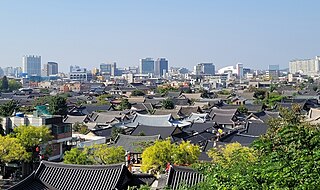
North Gyeongsang Province is a province in eastern South Korea,and with an area of 19,030 km2 (7,350 sq mi),it is the largest province in the Korean peninsula. The province was formed in 1896 from the northern half of the former Gyeongsang province,and remained a province of Korea until the country's division in 1945,then became part of South Korea.

Daegu,formerly spelled Taegu and officially Daegu Metropolitan City,is a city in southeastern South Korea.

Jeonju is the capital and largest city of North Jeolla Province,South Korea. It is both urban and rural due to the closeness of Wanju County which almost entirely surrounds Jeonju. It is an important tourist center famous for Korean food,historic buildings,sports activities,and innovative festivals.

Namdaemun,officially known as the Sungnyemun,is one of the Eight Gates in the Fortress Wall of Seoul,South Korea. The gate formed the original southern boundary of the city during the Joseon dynasty,although the city has since significantly outgrown this boundary. It is located in Jung-gu between Seoul Station and Seoul Plaza,with the historic 24-hour Namdaemun Market next to the gate.

Gyeongbokgung,also known as Gyeongbokgung Palace,was the main royal palace of the Joseon dynasty. Built in 1395,it is located in northern Seoul,South Korea. The largest of the Five Grand Palaces built by the Joseon dynasty,Gyeongbokgung served as the home of the royal family and the seat of government.

Gimcheon is a city in North Gyeongsang Province,South Korea. It is situated on the major land transportation routes between Seoul and Busan,namely the Gyeongbu Expressway and Gyeongbu Line railway.

Miryang,formerly also spelled as 推火郡,Milbeol (密伐) and Milseong (密城),is a city in Gyeongsangnam-do Province,South Korea. Its name is originated from the tribal country named Miri midong guk (彌離彌凍國). There are various hypotheses as to the meaning of Miryang,such as Milky Way,Galaxy,dragon's field,The Wheat Field and the watery field. Neighboring cities include Changnyeong to the west,Cheongdo to the north,Ulsan to the east,and Yangsan,Gimhae,and Changwon to the south. The city bird is the Korean magpie,the city tree is the pine,and the city flower is the royal azalea.

On February 18,2003,an arsonist set fire to a Daegu Metro subway train as it arrived at Jungangno station in central Daegu,South Korea. The resulting blaze,which spread when a second train stopped at the same station,killed 192 people and injured another 151. It remains the deadliest loss of life in a single deliberate incident in South Korean peacetime history,surpassing the 1982 shooting rampage committed by Woo Bum-kon.

Insa-dong (Korean: 인사동) is a dong,or neighborhood,in Jongno District,Seoul,South Korea. Its main street is Insadong-gil,which is connected to a number of alleys that lead deeper into the district,with modern galleries and tea shops. Historically,it was the largest market for antiques and artwork in Korea.
Throughout and before recorded history,Daegu has served as a nexus of transportation,lying as it does at the junction of the Geumho and Nakdong rivers. During the Joseon dynasty,the city was the administrative,economic and cultural centre of the entire Gyeongsang region,a role largely taken over now by Busan in South Gyeongsang Province.
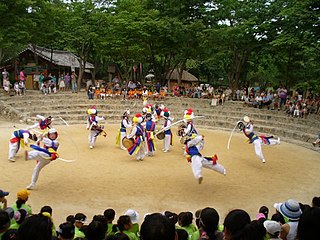
Korean Folk Village (Korean: 한국민속촌) is a living museum type of tourist attraction in the city of Yongin,a satellite city in the Seoul Metropolitan Area in the province of Gyeonggi in South Korea. It was first opened on October 3,1974. Korean Folk Village is a popular tourist destination for both Koreans and foreigners,located near South Korea's largest amusement park,Everland.

Namdaemun Market (Korean: 남대문시장) is a large traditional market in Seoul,South Korea. It is located next to Namdaemun,the main southern gate to the old city. The market is among the oldest extant markets in Korea,having opened during the Joseon period in 1414.

Jung District is a gu,or district,covering the downtown area of Daegu,South Korea. It borders most of the other districts of Daegu,including Nam-gu to the south,Seo-gu to the west,Buk-gu to the north,and Dong-gu and Suseong-gu to the east. The northern border is formed by the Gyeongbu Line railroad,and the eastern border by the Sincheon stream.

Gwanghwamun is the main and largest gate of Gyeongbok Palace,in Jongno-gu,Seoul,South Korea. It is located at a three-way intersection at the northern end of Sejongno. As a landmark and symbol of Seoul's long history as the capital city during the Joseon Dynasty,the gate has gone through multiple periods of destruction and disrepair. The most recent large-scale restoration work on the gate was finished and it was opened to the public on August 15,2010.

Bupyeong District is one of the 10 administrative divisions that comprise Incheon,South Korea. Bupyeong-gu comprises an area of 12.35 square miles,and has a population of 508,587. It is located north of Namdong-gu,east of Seo-gu,and south of Gyeyang-gu. The city of Bucheon,in neighboring Gyeonggi Province,comprises its eastern limit.
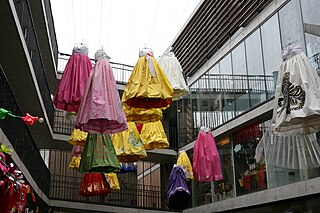
Seoul,the capital of South Korea,has many shopping areas and markets throughout the city. Famous ones include Myeong-dong,Cheongdam-dong,the Hongdae area,and the Dongdaemun and Namdaemun markets.
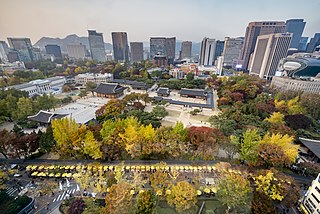
Seoul,officially Seoul Special City,and formerly known as Hanseong and Keijō,is the capital of the Republic of Korea (ROK),commonly known as South Korea,and the country's most extensive urban center. The broader Seoul Capital Area,encompassing Gyeonggi province and Incheon metropolitan city,emerged as the world's fourth largest metropolitan economy in 2014,trailing only Tokyo,New York City,and Los Angeles,hosting more than half of South Korea's population. Although Seoul's population peaked at slightly over 10 million,it has gradually decreased since 2014,standing at approximately 9.97 million residents as of 2020. Seoul is the seat of the South Korean government.
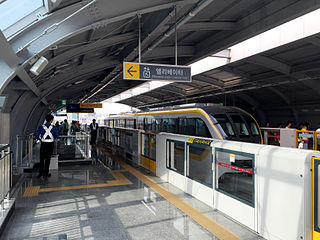
Seomun Market Station is a station of Daegu Subway Line 3 in Daesin-dong,and Sijangbungno,Jung District,Daegu,South Korea. It is named after Seomun Market,and is also called Dongsan Medical Center Station.
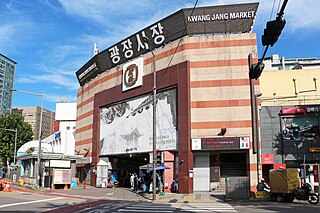
Gwangjang Market (Korean: 광장시장),previously Dongdaemun Market (동대문시장),is a traditional street market in Jongno-gu,Seoul,South Korea. The market is one of the oldest and largest traditional markets in South Korea,with more than 5000 shops and 20,000 employees in an area of 42,000 m2 (450,000 sq ft). Approximately 65,000 people visit the market each day.
Retailing in South Korea consists of hypermarkets,department stores,flea markets,traditional markets,and underground shopping malls. Hypermarkets sell dry goods and groceries,similar to Western supercentres. Traditional markets are also popular throughout South Korea.


















